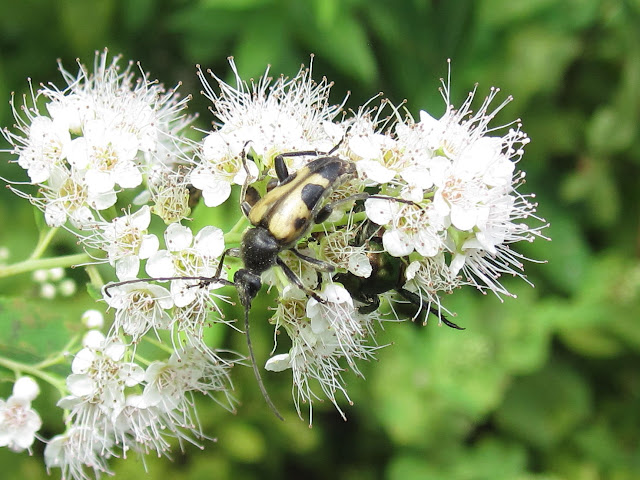 |
| You're not coming down my trail! (Photo by Doug J.) |
I didn't see any large animals this week, but lots of smaller ones were enjoying the warm weather. On one morning kayak I came across a mixed flock of birds moving along the trees on the shore of the lake picking off insects of all forms for their breakfast. There were chickadees and yellow warblers plucking caterpillars off leaves, woodpeckers grabbing ants and eggs from trunks, and kingbirds and phoebes snatching adults right out of the air. These flycatchers are the most fun to watch as they launch from a bare branch, perform a few acrobatics over the lake to catch their prey, then alight back on the branch to watch for another victim. It's a precarious life, that of an insect.
 |
| Phoebe |
 |
| Black-capped Chickadee |
And sometimes it's pretty easy for birds to get a good meal. I noticed this lovely swarm of caterpillars munching away on the bottom of some leaves, doing a pretty good job of decimating the tree.
 |
| Dogwood Sawfly Larvae (Macremphytus tarsatus) |
I didn't know what they were, and it took some work to figure it out, mostly because, as I found out, they aren't technically caterpillars. I learned that "caterpillar" applies specifically to the larvae of butterflies and moths, and these are the larvae of a wasp - the Dogwood Sawfly wasp. Although it is in the wasp order of insects, it does not sting. I'll keep an eye out for adults next week. (In case you were wondering, yes, that is a dogwood they were feeding on.)
And it must be the season for longhorn beetles. Two weeks ago I saw the tremendous Pine Sawyer, and this week I saw its little brother, the Black and Yellow Longhorn beetle drinking nectar from the Meadowsweet flowers.
 |
| Black and Yellow Longhorn Beetle (Typocerus sparsus) |
I saw one other really neat insect this week while doing work on the Fogg Hill conservation property just north of Lake Waukewan - one of the strangest bugs you'll find, and one that isn't often seen: the Northern Walkingstick.
 |
| Nothern Walkingstick (diapheromera femerata) |
The reason I rarely see them is their great camouflage - they look like sticks! I only saw this one because it came to me - it ended up right on my backpack, probably when I brushed by it. This one was almost three inches long. The male walkingstick is brown, so this is a female.
The one large animal I did see this week was pretty easy to find.
 |
| A Great Blue Heron in a rather conspicuous spot |
This handsome heron spent at least half an hour in the early morning just perfectly balanced on one leg watching the sun rise. It wasn't fishing or frogging, but just standing there watching the day unfold.
 |
| Amazing balance |
On occasion it would do a little preening, and as it ruffled up its feathers it looked an awful lot like the patriarch of Lake Wicwas, wise and grey, with its long flowing beard giving testament to its stature on the lake.
Birds and insects - the most active creatures during this hot summer week.

Great post. This past weekend I rode through an oak forest that was decimated by gypsy moth caterpillars. It was like riding through the forest after leaf drop, except there were no leaves on the ground!
ReplyDelete